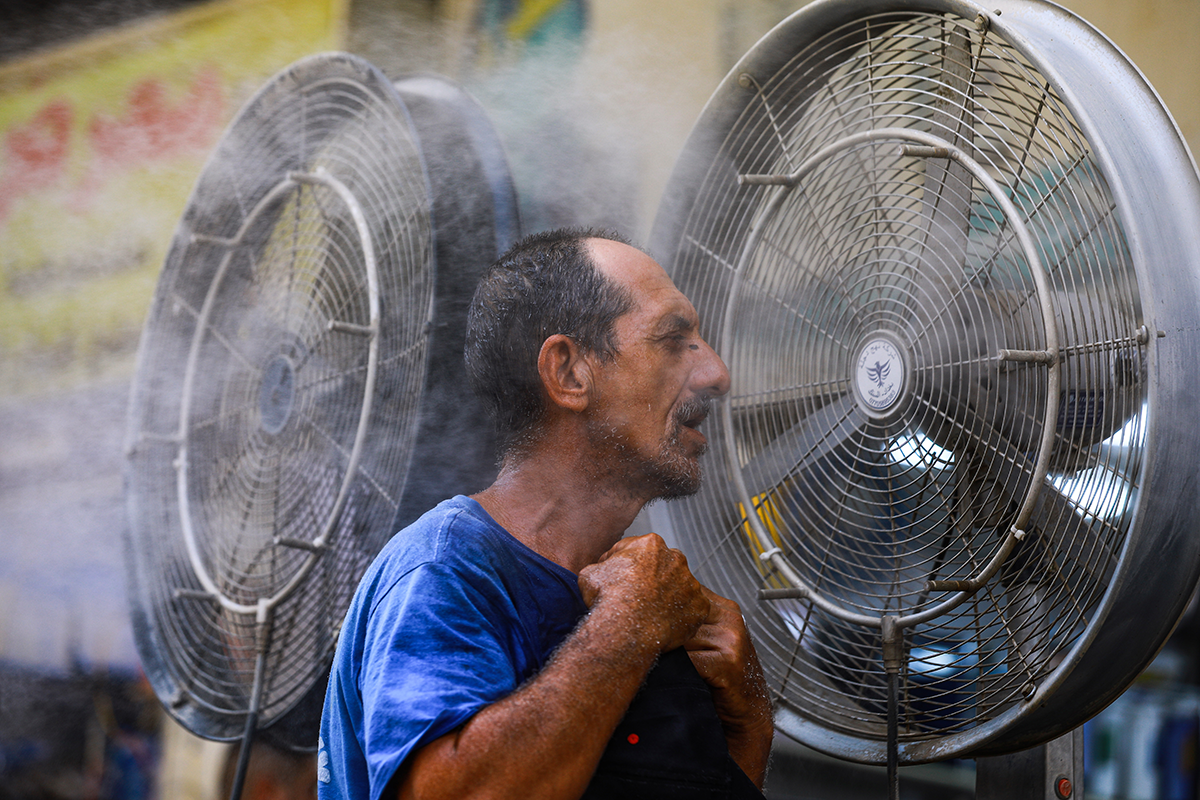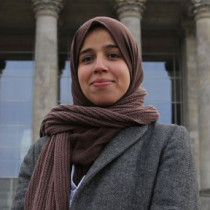

Introduction
What began as a summer heatwave of significantly above-normal temperatures in Europe expanded to a series of successive heatwaves that has afflicted most of the northern hemisphere. Temperatures reached and remained at substantially elevated levels in the months of June and July, breaking historical records in many countries across Europe, Asia, North America, and the Middle East.
Besides an increase in the number of extremely hot days compared to previous years, these hot spells have caused numerous heat-related fatalities — primarily among the elderly and those with no access to air conditioning. In addition, the extreme heat and corresponding lack of moisture has generated numerous wildfires that have multiplied the heat-related death toll and disrupted agricultural productivity.
Following last summer’s record-breaking temperatures in the Middle East, this summer’s extreme heat, impacting areas not usually prone to reaching such levels, is alarming. What are the short-term implications of this year’s abnormal heatwaves, and how can we address the long-term concerns that will emerge from successive summers with more frequent and intensifying torridity?
Photo by Ameer Al-Mohammedawi/picture alliance via Getty Images
Viewpoints
-
Malak Altaeb
Malak Altaeb

Europe is heating up quicker than expected, highlighting the global nature of climate challenges
Severe heatwaves have affected countries across Europe in 2022, including Germany, the United Kingdom, Spain, and France. Temperature changes on the continent have fluctuated dramatically in recent years; heatwaves are becoming increasingly common and summers are getting hotter for longer than ever before. Temperatures projected for 2050 less than a decade ago have already become a reality.
In 2014, French weather presenter Évelyne Dhéliat forecast what the weather might be like in France in August 2050, using projections from the World Meteorological Organization. She predicted that after decades of additional warming, the temperature would rise to 42.78°C in southern France. That has happened far sooner, however, with France registering a high of 44°C this summer — its highest temperature since the heatwave of 2003. Rapidly rising temperatures have underscored Europe’s changing reality and shown how directly it is impacted by climate change.
The ongoing heatwaves in Europe are not only a problem for the continent; they are also an alarming sign for other regions, such as the Middle East and North Africa (MENA), which have already been heating up for the past decade. As these directly indicate the rapidly increasing impact of climate change, global action is required now more than ever. Regardless of the mounting evidence, the MENA region was not considered seriously during the last decade of increasing global warming, which created an additional burden for the region on top of its existing economic and political instabilities. However, Europe’s current heatwave should prompt countries across the MENA region to take immediate action to help vulnerable communities better adapt to global warming and highlight the apparent climate injustices between countries in the Global South and Global North on this matter.
Unfortunately, people are often not especially aware of the long-term impact of rising temperatures since those changes are typically felt seasonally, and then only in the short term. Yet high temperatures impact not only the environment but also people’s daily lives and health, both physical and mental. They lead to dehydration and dizziness and limit people’s ability to concentrate, work, and remain productive to conduct day to day activities.
Summer heatwaves also affect livelihoods on many different levels, impacting areas as varied as energy, agriculture, and migration. Many buildings in Europe were not built to handle high summer temperatures; they end up retaining heat inside for longer periods, instead of keeping it outside. High temperatures have also reduced the soil quality across the continent, turning many green areas into pale yellow burnt patches. This directly impacts soil production and the quality and quantity of agricultural produce given the decline in soil moisture. Environmental migration is becoming increasingly likely, as extreme heat pushes people to move from high-temperature areas to cooler ones, and it is a concept that not only applies to the Global South but also countries in the Global North, too.
Addressing these varied impacts requires effective emergency policy measures that can support people’s livelihoods during hot summers and tackle energy, infrastructure, and food security challenges. Mitigation efforts, in the form of the green transition Europe has been pursuing for the past few years, will no longer suffice; adaptation measures must be considered as well. This could include, for example, helping cities adapt to become cooler during heatwaves.
This year’s hot summer across Europe has shown how climate change is, indeed, a global issue. It severely affects both developing and developed countries alike. Addressing the rapidly rising temperatures around the world will require a coordinated global effort.
Malak Altaeb is a non-resident scholar with MEI’s Climate and Water Program and an independent consultant, writer, and researcher based in Paris, France.
-
Gökçe Şencan
Gökçe Şencan

Severe heat waves are giving us a window into the future
A drying and warming trend is currently affecting the Mediterranean Basin. Climate change is driving up summer temperatures and leading to more extreme weather events, including prolonged and extreme heatwaves. These heatwaves take a heavy toll, impacting the physical wellbeing of humans and multiplying the risk of food insecurity, as crop failures become more likely. India experienced this exact scenario earlier this year, when the country’s government banned wheat exports due to expectations of a declining harvest following a severe heatwave. The global wheat supply chain was already experiencing disruptions due to the war in Ukraine, and this heatwave only compounded the problem.
Heatwaves also impact the daily lives of people in numerous ways. In addition to food insecurity, heatwaves cause both personal and agricultural water use to spike, and countries with chronic water scarcity issues may face challenges meeting the increased demand. Prolonged exposure to elevated temperatures also poses a critical risk to the health of vulnerable populations like children and the elderly. Outdoor workers and low-income groups are at particular risk as well, as they have more limited access to air-conditioned environments and urban green spaces, which create a cooling effect in cities and provide a refuge from the heat. There is some evidence that high temperatures and heatwaves can increase the likelihood of interpersonal violence and exacerbate existing mental health issues. As a result, it is important to additionally evaluate climate change from a public health standpoint and craft policies with this in mind.
In the future, the Middle East should expect more frequent and deadly heatwaves that will continue to impact the most at-risk groups, which usually happen to be those least responsible for climate change. To minimize water scarcity risks during heatwaves, governments in the region could implement policies such as supporting drip irrigation, expanding the use of heat- and drought-tolerant crops, and investing in alternative water-supply technologies, like recycling. To support climate resilience in low-income neighborhoods, governments can build and expand urban green spaces and provide funding for climate-related public health measures. These measures can include the establishment of cooling centers and reimbursement programs for air conditioners and air filters to counter heatwaves, as well as poor air quality during the summer wildfire season.
The severe heatwaves of the past few years — and the social and economic tolls they have taken — are offering us a window into the future. It is important that Middle Eastern governments acknowledge these changing conditions and act urgently to prepare for and respond to them.
Gökçe Şencan is a research associate at the Public Policy Institute of California's (PPIC) Water Policy Center and a non-resident scholar at the Middle East Institute’s Climate and Water Program.
-
Andrei Covatariu
Andrei Covatariu

Alternating droughts and floods harm Europe’s water-food-energy nexus
Europe is currently facing severe concurrent energy and food crises. Although neither was generated primarily by climate change, the water-energy-food equilibrium has been drastically affected by severe and consecutive heatwaves across the continent, in what the European Commission Joint Research Centre (EC-JRC) is already calling “the worst [drought] in 500 years.”
Steady levels of water flows and water temperature play a critical role in the production of electricity. Low water levels (caused by both limited rain and snowfall in the previous winter as well as evaporation due to the recent heatwaves) are resulting in decreased electricity generation and even complete shutdowns of hydropower plants across Europe. Additionally, low water flows and high water temperatures are disrupting nuclear power plants and other thermoelectric generators, which need significant volumes of cool water to operate. Lastly, shallow river levels (e.g., the Rhine River) are disrupting barge-borne coal deliveries, adding further pressure on the availability of the continent’s fuel stocks. These upward trends come amidst already record-high electricity prices caused by Russian natural gas supply disruptions and ahead of what is expected to be a challenging winter season.
At the same time, the ongoing food crisis (mainly stemming from the supply disruptions caused by the Russo-Ukrainian conflict) is being further exacerbated by the persistent extreme summer temperatures and drought conditions. This is impacting not only the continent itself but also its trade partners in neighboring regions. The Middle East and North Africa region (MENA) is notably one of the main export markets for European Union food producers — with Saudi Arabia, Turkey, Algeria, Morocco, Israel, the United Arab Emirates, and Egypt together purchasing nearly 18.5 billion euros worth of European foodstuffs in 2020. This year, European countries are reporting extensive losses across a vast range of agricultural products. Several state governments have temporarily banned irrigating farmland because of water shortages are already affecting people’s basic needs; in response, the European Union recently issued recommendations for reusing treated wastewater for irrigation purposes.
The close relationship between energy and food production poses additional challenges as well: High electricity prices have inevitably affected irrigation practices this year by changing the cost structure for crop producers, as electricity is critical for water pumping systems. Moreover, as natural gas prices soared in 2021 and 2022, the fertilizer industry (producing vital agricultural inputs, especially in years marked by water shortages), which relies on gas for its production processes, has experienced increasing costs. This has also translated into higher retail food prices.
As harmful as this year’s drought has been, the water-energy-food nexus can just as easily be disrupted by the other extreme. Last year’s floods in Germany seriously affected agricultural lands, destroying crops. Likewise, abnormally abundant precipitation levels severely disrupt the functioning of electricity generators and the power grid.
The alternation of extreme droughts (heatwaves in most European countries, in 2018 and 2022) and severe floods (in 2021, in Germany) has made the water-energy-food balance even harder to maintain absent consistent and immediate investments in climate adaptation. The increase in both the frequency and intensity of extreme weather events is disturbing, despite the fact that this phenomenon has been repeatedly highlighted by Intergovernmental Panel on Climate Change (IPCC) reports — particularly with reference to regions in the Global South, including MENA. But while the direction of these worsening climate trends become less uncertain with every passing year, the measures necessary to tackle their large-scale effects have yet to be widely deployed.
Andrei Covatariu is a Co-founder of ECERA (Ecological Economics Research for Action), a network of practitioners aiming to produce policy-relevant knowledge on the various facets of sustainability. He is also a Non-Resident Scholar with MEI’s Climate and Water Program.
-
Hafsa Halawa
Hafsa Halawa

The MENA region is out of time when it comes to climate change
The Middle East and North Africa (MENA) region has been experiencing more frequent and more dangerous climate shocks with every passing year in recent decades. This year’s horrific dust storms, flash floods, droughts, and searing temperatures are not new, nor were they truly unexpected. The increasing frequency of such weather events, however, demands serious and urgent reflection on the state of democracy and governance in an area of the world desperately crying out for a response from its leaders.
The region remains one ruled by authoritarians. Those governments not at war have successfully repressed their citizens, silencing them into submission through violence, political co-optation, or financial insecurity on such a scale that any attempt to realize democratic change following the decade of Arab Uprisings is almost meaningless. But climate change presents a wholly different challenge to these same authoritarians who have successfully snuffed out movements calling for political reform. The threat of climate change brings with it a return to the meaning of human rights activism — where the rights to life, clean water, healthcare, and education trump political rights to organize, or civic rights to mobilize and represent one’s interests. And the sheer damage being caused by these climatic shocks, as well as their growing frequency, is raising renewed questions across the MENA region about the legitimacy and inclusiveness of official responses.
Such factors are compounded by the fact that climate change is not the only reason why the region finds itself facing such a bleak future. Corruption has arguably played the greatest role in marginalizing local populations for the benefit of a very small circle of elites in almost every MENA state. But that corruption has also brought with it air and water pollution, dangerous urban planning models, poor infrastructure, and agricultural mismanagement, which contribute just as much to the weather-related traumas now being experienced as climate change itself.
And so, while regional leaders criticize democracy as a Western import or use the rise of fundamentalists as a smokescreen to endorse brutal crackdowns against civic actors and the wider population, climate change merely reminds them, and us, that the region is out of time. There is no longer time to talk about corruption as a side issue or use it as a campaign slogan to buy cheap votes. There is no longer time to ignore poor infrastructure, lack of basic services, or polluted waters. There is no longer time to put off diversifying economies merely because there is still oil in the ground, yet to be extracted.
The risk of revolution or popular uprising should no longer be the bar against which these leaders show willingness or susceptibility to respond. Nor should it be the basis upon which the international community balances its urgency to respond to or engage in issues related to democracy and governance versus hard security matters that wed it to the region’s authoritarian regimes. It is no less than a battle for life or death. Leaders across MENA must come together and immediately change course, acting for themselves — if not for their populations — to salvage the future of a region that is now expecting shocks so severe and so damaging that they risk the lives of millions.
Hafsa Halawa is a non-resident scholar at the Middle East Institute and an independent consultant working on political, social and economic affairs, and development goals across the Middle East and North Africa and Horn of Africa regions.
-
Iulia-Sabina Joja
Iulia-Sabina Joja

Europe’s drought and Russia’s energy blackmail
This summer’s record-breaking droughts are creating a two-pronged crisis in Europe that links climate concerns and energy security, with far-reaching implications for neighboring regions. At the center of this nexus lie Germany and Russia. Last month, Germany’s Foreign Minister Annalena Baerbock (a leading member of the Greens political party) spelled out the nature of the climate-energy crisis Europe is facing, calling it a “climate emergency” and “the most challenging security issue of our time.” She urged European countries to reduce their energy dependence on Russia and to invest in renewable sources. Increasingly frequent climate emergencies, like the current heatwaves and droughts gripping Europe, are forcing Europeans to restructure their energy systems in green terms at a faster pace than they can cope with. Germany, as Europe’s largest economy and the continent’s most important consumer of Russian hydrocarbons, lies at the heart of this dilemma. Russia, by contrast, is doing everything it can to prevent the European states from liberating themselves from carbon emissions and dependence on Russian energy.
This energy crisis became particularly acute last fall, when Russia started reducing natural gas and oil supplies to Europe. Under pressure, Europeans, with the help of the United States, have been seeking alternative sources, mostly of gas and oil, while implementing gradual energy sanctions and self-imposed boycotts on Russia after the latter’s Feb. 24 invasion of Ukraine. European attention has turned, in particular, to courting Middle Eastern and North African energy producers, among others. The energy shortages Europeans continue to face, however, have also increased the importance of other energy resources, including coal, nuclear, hydro, solar, and wind. But the difficulty for Europe has been to opt for greener sources than gas and oil. Instead of increasing nuclear energy production, countries like Germany have paradoxically preferred coal, the “dirtiest” of energy fuels.
Then came the summer drought. The consequences for energy, industrial, and agricultural production are still unfolding, but the preliminary results are already striking. With many major European rivers drying up, the transportation of goods along internal waterways had to be radically reduced. Nuclear and hydroelectric power generation have had to be substantially cut as well, by 11% and 20% respectively. This has also meant an increase in the importance of coal. German energy producer RWE is notably replacing gas with coal due to Russian-caused shortages. And while Russia is forcing Europe to rely more on coal and alternative sources of oil and gas, Moscow is flaring gas at the Finnish border to prevent it from reaching Europe.
After this summer’s devastating drought, Europe will face a cold winter. The Kremlin is likely to continue to use Europe’s remaining energy dependence on it for blackmail, even if this results in major costs for the already heavily battered Russian economy. The drought’s consequences on agriculture will solidify European voters’ understanding of climate as a security challenge of the utmost importance. The silver lining of this energy-climate crisis, however, may be that, at least in the long run, Europe will continue to lead world efforts toward greener energy production and consumption.
Dr. Iulia-Sabina Joja is a senior fellow and director of MEI’s Black Sea program, the Frontier Europe Initiative, and project director of “Afghanistan Watch.”











